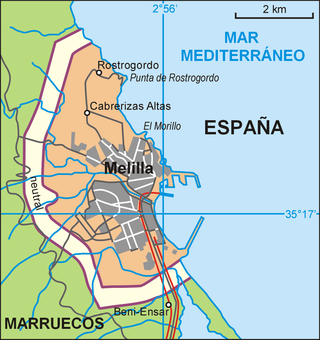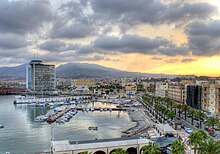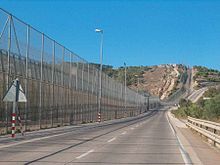Melilla
|
Melilla ( Spanish ) Melilla |
|||||
|---|---|---|---|---|---|
|
|||||
| Basic data | |||||
| Country : |
|
||||
| Area : | 13.4 km² | ||||
| Residents : | 86,487 (January 1, 2019) | ||||
| Population density : | 6,454.3 inhabitants / km² | ||||
| Expansion: | North – South: approx. 8 km West – East: approx. 4 km |
||||
| ISO 3166-2 : | ES-ML | ||||
| Website : | www.melilla.es | ||||
| Politics and administration | |||||
| Autonomy since: | March 14, 1995 | ||||
| President : | Juan José Imbroda ( PP ) | ||||
| Representation in the Cortes Generales : |
Congress : 1 seats Senate : 2 seats |
||||
| map | |||||
Melilla ( pronunciation : [ meˈliʎa ], Central Atlas Tamazight ⵎⵕⵉⵜⵛ Mṛitc ) is a Spanish city on the North African Mediterranean coast with a land border with Morocco . As a Spanish exclave , Melilla belongs to the European Union , but is excluded from the customs territory of the EU according to the Union Customs Code . Melilla is also not part of the Schengen area . The area covers 13.4 km², on which about 86,487 inhabitants live (as of January 1, 2019).
Melilla has been under Spanish ownership since 1497; Even after Morocco gained independence from the colonial powers France and Spain (1956), Melilla and Ceuta, also located in Africa, remained Spanish. The old town of Melilla (Medina Sidonia) is recognized as a cultural asset ( Bien de Interés Cultural ) in the Conjunto histórico-artístico category .
location
Melilla is located on a peninsula (Cabo de Tres Forcas) on the African continent and is surrounded by border fortifications. Nador , the closest city on Moroccan soil, is about ten kilometers south. The distance of the ferry connection to Malaga is about 190 kilometers; to Almería it is around 180 kilometers.
structure
Melilla is divided into eight boroughs (barrios) :
- Barrio de Medina Sidonia
- Barrio del General Larrea
- Barrio del Ataque Seco
- Barrio de los Heroes de España
- Barrio del General Gómez Jordana
- Barrio del Príncipe de Asturias
- Barrio del Carmen
- Barrio del Polígono Residencial de La Paz
history
Early history
Melilla possibly goes back to a foundation of the Phoenicians , who lived here around 1100 BC. Founded a trading center and a settlement called Rusadir . Later the settlement became Carthaginian , then it belonged to the Kingdom of Mauritania , which was integrated into the Roman province of Mauretania Tingitana in 42 AD .
middle Ages
In the 5th century, the place was first conquered by the Vandals , then by Ostrom around 535 , which, however, had to give way to the Arabs in 705, who destroyed the settlement.
Rebuilt in the 9th and 10th centuries, it again became the end point of an important caravan route between the Mediterranean and the desert city of Sijilmassa . Abd ar-Rahman III. ordered in 927 the conquest of Melilla and the entire north coast of Morocco, which he saw threatened by the Shiite Fatimids . Around 1030 Melilla belonged to the partial kingdom ( taifa ) of Málaga . Under the Merinids , Melilla temporarily fortified the border between the kingdoms of Tlemcen and Fez .
In 1497, five years after the conquest of Granada , the city was conquered by order of the Catholic kings Isabella I of Castile and Ferdinand II of Aragon during the weak rule of the Moroccan Wattasid dynasty. The city was seen as a base for further activities in North Africa and was given to the dukes of Medina-Sidonia .
From 1556 it was directly under the Spanish crown.
Modern times
After several unsuccessful sieges (the last in 1774/1775), Melilla was expanded into a fortress city by the Spanish in the 17th and 18th centuries.
Permanent conflicts in northern Morocco, which were also fomented by the European powers France, Spain and the German Empire, finally culminated in the Rif War (1921–1927), which was also fought with the use of poison gas . On July 17, 1936, parts of the Spanish troops stationed in Melilla rose against the Second Spanish Republic under the leadership of General Francisco Franco , thus triggering the Spanish Civil War .
Latest time
Since the founding of the state in 1956, Morocco has claimed Melilla, Ceuta, some 400 km to the west, as well as some small Spanish islands off the African coast, which also belong to the group of Plazas de soberanía . The territorial claims are not pushed forward, however, as Morocco benefits from Melilla in many ways (trade with Europe, status of the Western Sahara regions ).
Until March 14, 1995, Melilla was part of the province of Málaga . Since then it has been an "autonomous city" ( Ciudad autónoma ) and enjoys similar rights as the autonomous communities of the mother country. The latter also applies to Ceuta . Melilla is thus an integral part of the Spanish national territory and the European Union , but not NATO , and has some special rights. In particular, it belongs to Art. 3 para. 1 Customs Code not part of the customs territory of the European Union .
Population development
| year | 1960 | 1970 | 1981 | 1991 | 2001 | 2011 |
|---|---|---|---|---|---|---|
| Residents | 79.056 | 64,942 | 58,449 | 63,670 | 66,411 | 78,476 |
At the first census in 1877, Melilla had only about 1,500 inhabitants; ten years later it was around 5,500 and in 1900 around 10,000.
- religion
More than half of the almost 85,000 inhabitants of Melilla are Muslims . There are probably even more because thousands of Moroccans live illegally in the city. A district of Melilla is considered a jihadist meeting point (likewise a district in Ceuta ).
politics
Migration to Europe
Migrants from sub-Saharan Africa keep trying to get to Melilla via Algeria and Morocco and from there to Spain or other countries in the European Union . They camp in the forest areas of Monte Gurugú and are provided with water and food by aid organizations. To protect against illegal immigration, the city is secured with three to six meter high fences (perímetros) as well as with motion detectors , night vision devices and cameras; the Guardia Civil also patrols . The situation worsened for the first time at the end of September 2005 after it became known that the Spanish government had reinforced the security systems ( Frontex mission Hera ). Since then, there have been a total of 15 deaths during border crossings. Morocco deported migrants turned away at the Melilla border fortifications to neighboring countries in the south; Morocco was accused by international aid organizations of having abandoned them in the desert. However, the Moroccan government denied this.
In June 2008, dozens of African migrants again made their way into the Spanish exclave in two waves. Several border police officers are said to have been injured. Only a few reached the city, 50 people were picked up and taken to deportation camps. Something similar was repeated in 2012, 2013 and 2014. At the beginning of 2014, the number of migrants staying near the border fortifications was estimated at 30,000 people. In 2014, according to Spanish figures, there were 65 storms on the border installations, in which around 2,000 people managed to gain access. On June 26, 2016, about 30 people broke through the border fortifications with Spanish territory. On August 20, 2016, 40 out of 150 people managed to get over the border fence. On May 9, 2017, 110 people climbed over the border fence. On January 6, 2018 there were 209.
On October 21, 2018, over 300, mostly male, Africans from countries south of the Sahara tried to get to Melilla. One of them suffered a cardiac arrest and 19 others were injured. 200 of them managed to reach EU territory - they were then taken to the initial reception center.
On July 19, 2019, 200 Africans attempted to overcome the border fortifications in a coordinated action; around 50 ended up on EU territory. By then, 2,498 had already gained irregular access to Melilla in 2019.
On February 13, 2020, the Grand Chamber of the European Court of Human Rights decided that migrants who had entered may be returned immediately . It thus revised the previous chamber decision of the ECHR from 2017.
Twin cities
-
 Almeria , Spain
Almeria , Spain -
 Caracas , Venezuela
Caracas , Venezuela -
 Cavite , Philippines
Cavite , Philippines -
 Ceuta , Spain
Ceuta , Spain -
 Málaga , Spain
Málaga , Spain -
 Montevideo , Uruguay
Montevideo , Uruguay -
 Motril , Spain
Motril , Spain -
 Toledo , Spain
Toledo , Spain -
 Mantua , Italy
Mantua , Italy
Assembly
Economy and Infrastructure
economy
The main industries in Melilla are fish processing and shipbuilding . Mainly fish and fruit as well as iron and lead ores are exported from the free port . Other economic pillars of the city are cross-border trade and financial transfers from mainland Spain and other EU countries . The only official currency is the euro , but many shops also accept Moroccan dirhams .
When compared with the EU's GDP , expressed in purchasing power standards, Melilla achieved an index of 95 (EU-27: 100) (2006). In 2017 the unemployment rate was 27.6%.
traffic
From the port of Melillas there are regular ferry connections to Málaga and Almería on the Spanish mainland. The crossing takes about 7.5 hours.
The Melilla Airport ( IATA airport code MLN) is located about four kilometers southwest of the city center near the border with Morocco; it opened in 1969. From here, only national flights to mainland Spain and Mallorca are possible. The Helipuerto de Melilla is used for military purposes.
Buses run about half an hour to the Moroccan Nador . At the border you have to change to another bus.
Culture and sights
- The old town hill, also called Medina Sidonia , is fortified all around and is the old center of the town. In the angled and sometimes sloping streets there are cisterns (aljibes) and storage rooms (almacenes) , which ensured the water and food supply during times of siege.
- There is also the lighthouse and several museums, including the Museo de Arqueología e Historia de Melilla with exhibits on the city's history.
- In the Church of the Purísima Concepción (1687, reconstructed in 1757), a statue of Nuestra Señora de la Victoria , the patron saint of the city, is venerated .
- In the mostly right-angled streets of the New Town and in the Plaza de España there are many houses in the style of Spanish Modernism from the last third of the 19th and the first third of the 20th century. After Barcelona and Madrid, Melilla is one of the most important cities of Spanish Wilhelminian architecture.
Personalities
Sons and daughters of the town:
- Fernando Arrabal (* 1932), Spanish-French writer and poet
- Araceli Jover (* 1971), Spanish actress
- Farid Bang (* 1986), German-Moroccan rapper ( Farid Hamed El Abdellaoui )
Web links
- Official website of the city (Spanish)
- Buildings in Melilla - Info (Spanish)
- Museums in Melilla - Photos + Info (Spanish)
- A protective wall for Europe - the fence in Melilla is the symbol for Fortress Europe , ZDF May 4, 2017
Individual evidence
- ↑ Cifras oficiales de población resultantes de la revisión del Padrón municipal a 1 de enero . Population statistics from the Instituto Nacional de Estadística (population update).
- ↑ Art. 4 para. 1 indent 8 of Regulation (EU) No. 952/2013 of the European Parliament and of the Council of October 9, 2013 establishing the Union Customs Code (new version) . In: Official Journal of the European Union . L 269, October 9, 2013, p. 11 .
- ^ François Papet-Périn: La mer d'Alboran ou Le contentieux territorial hispano-marocain sur les deux bornes européennes de Ceuta et Melilla. Thèse de doctorat d'histoire contemporaine soutenue en 2012 à Paris 1-Sorbonne sous la direction de Pierre Vermeren.
- ↑ Gordon Carmele: The Spanish political system online on books.google.de
- ↑ FAZ.net September 1, 2017: The mosque in the gorge of death
- ↑ Morocco brings Africa refugees back from the Sahara. In: Spiegel Online . October 12, 2005.
- ↑ African refugees storm the Spanish exclave Melilla. In: Der Spiegel. June 22, 2008.
- ↑ Refugees overcome the border wall to the Melilla exclave. In: Spiegel Online . August 19, 2012, accessed January 20, 2017.
- ↑ Decenas de inmigrantes entran en Melilla en dos asaltos de unos 400 subsaharianos. In: EFE . July 23, 2013, Retrieved July 23, 2013 (Spanish).
- ↑ 100 people tear down the fence: Refugees invade Melilla. In: n-tv.de. September 17, 2013, accessed January 20, 2017.
- ↑ Hundreds of Africans overcome border fence in Melilla. Deutsche Welle , March 18, 2014, accessed March 19, 2014 .
- ↑ Mass rush to Melilla: 30,000 refugees are on the borders with Spain. In: spiegel.de. February 17, 2014, accessed February 17, 2014.
- ↑ ( Page no longer available , search in web archives: 200 migrants storm Spanish North African enclave fence. ) In: The Washington Post. December 30, 2014.
- ↑ “African migrants force their way into Spain's Melilla enclave” africanspress.org of July 4, 2016
- ↑ Dozens of refugees overcome the fence after Melilla In: Der Spiegel online August 20, 2016.
- ↑ Migrants storm in Melilla on Spanish territory dw.de from May 9, 2017
- ↑ "More than 200 migrants overcame the barriers in the Melilla exclave" Der Standard from January 6, 2018
- ↑ 300 migrants storm the EU border fence in Morocco . In: news.ORF.at . October 21, 2018 ( orf.at [accessed October 21, 2018]).
- ↑ "Cincuenta inmigrantes logran saltar la valla de Melilla" elpais.com of July 19, 2019
- ↑ FAZ.net February 13, 2020: European Court of Justice allows "hot deportations"
- ↑ Contabilidad Regional de España. Base 2000. ( Memento of the original from September 24, 2015 in the Internet Archive ) Info: The archive link was inserted automatically and has not yet been checked. Please check the original and archive link according to the instructions and then remove this notice. In: ine.es. Instituto Nacional de Estadistica. December 27, 2007, accessed on January 20, 2017 (PDF; 65 kB, Spanish).
- ↑ Unemployment rate, by NUTS 2 regions. Retrieved November 5, 2018 .
Coordinates: 35 ° 17 ′ N , 2 ° 57 ′ W











